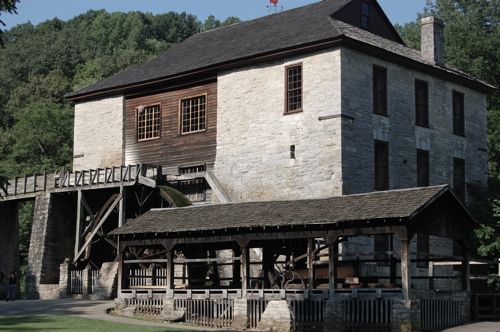Do gristmills ever explode?
And if they do, why? That from reader Afton, age 9. Boy is a question like that ever a great way to start a day, Afton! I thank you for it. The answer is…sometimes. However I’m not aware of many (or any) explosions having to do with corn mills. Wheat flour milling is another matter entirely. But then why should that be so? Both involve the grinding of grains. I believe the answer has to do with particle size. But first a little bit about what causes mill explosions.
Water-powered grain mills don’t employ fuels like many modern mills do, which means they don’t contain anything that we modern types normally think of as explosive. For us explosives are solid chemicals like TNT, volatile liquids like gasoline, gasses like propane or high-pressure vessels like boilers. However small particles suspended in air can be combustible and/or explosive if they’re present in a great enough concentration. A phenomenon like that is called a dust explosion and it’s all about surface area.
Think of a piece of wood. It can be set alight, but the burning can only happen on the wood’s surface where it’s exposed to oxygen. As a result the wood burns very slowly. But cut that piece of wood up and its surface area increases dramatically, and with it the rate at which it burns. Reduced down to fine particles (sawdust) the wood floats in air, meaning that all that surface area is exposed to oxygen on all sides. If a random spark is created and those particles are close enough to one another that a flame can leap from one to the next, you get a very fast-burning fire. If that fire happens to be in an enclosed space, outward-rushing gasses build up pressure and the result is an explosion.
Though we tend not to think of grain as being something that burns, it does. Since the process of grinding creates lots of small particles capable of going airborne, mills can be susceptible to these sorts of fires an/or explosions. However it’s at least my impression that corn-grinding gristmills don’t create fine enough particles. Flour mills do and so do saw mills, which is part of the reason many saw mills were outdoor operations way back when. Here’s a photo I took quite a while ago of a gristmill in Indiana.

Though it’s not very easy to make out, that structure in front there is actually a saw milling operation. In addition to driving the gears of the mill inside the main house, the water wheel also pushed a long saw blade back and forth, allowing the locals to get a twofer out of the water stream. But as you’ll notice they kept the saw mill well ventilated, since they didn’t want the whole place going up in flames. Thanks Afton! Hope this helps!
OMG Joe, they have a saw mill too, sign me up!
I’m quitting my job tomorrow!
I’ll get you a job application when I go!
My husband worked for many years in a corn milling facility and was no stranger to explosions and fireballs. He was once hit with a fireball while shoveling stuff down a chute and the only thing that saved him was the fact that he was drenched in sweat. Maybe the old grist mills weren’t prone to such fires but modern day corn milling definitely is.
Very interesting, Rosalie, thank you for the information — and I’m glad your husband survived his harrowing experience!
Take care,
– Joe